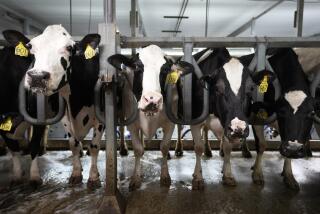It’s a Matter of Health
- Share via
Several strains of bacteria have in the last decade developed resistance to the most powerful antibiotics we can throw at them. One root of the problem is the livestock industry’s practice of dumping millions of pounds of antibiotics into animal feed and water every year. The antibiotics act as growth promoters--cheap ways of fattening livestock--but they also create “superbugs.” These mutant strains of bacteria have developed immunities to antibiotics and can infect humans who handle raw meat and poultry, or eat undercooked food. The virtually untreatable illnesses that may result range from unpleasant to deadly.
The European Union last year banned the use of antibiotic growth promoters in livestock if those same antibiotics are used to treat disease in humans. Last week, a coalition of 41 health and consumer groups called on the Food and Drug Administration to pass a similar ban in the United States.
Chances of that happening are slim, for reasons of politics, not science. Lobbyists for politically powerful drug companies, which rake in billions of dollars every year selling antibiotics to U.S. farmers, are pressuring Congress to prohibit the FDA from even implementing its newly proposed “framework.” That modest plan calls on the meat industry to study problem antibiotics and limit the use of especially harmful ones.
Lobbyists representing the livestock industry argue that any limit on the use of antibiotic growth promoters would have an “adverse to severe” impact on their industry. In fact, the industry knows that little economic harm followed when Britain banned the use of antibiotic growth promoters in 1969, or when Denmark did the same in 1996. Last year, a National Academy of Sciences study used the industry’s own estimates to calculate that if the entire livestock industry eliminated the use of antibiotic growth promoters--though not antibiotics used to fight animal illnesses--the added costs would be no more than $10 per American consumer per year.
Congress has buckled to the industry’s arguments in the past. When FDA scientists first proposed curtailing antibiotic growth promoters in 1980, the House Agriculture Committee promptly passed a measure stating, “FDA will be expected to continue to hold in abeyance any implementation of its proposal.” And when the agency tried again to protect the public safety in 1985, the Senate Agriculture Committee stood in its way, cryptically referring to unspecified “information” it had which “calls into question” the results of a National Academy of Science study showing that antibiotic use in livestock, along with antibiotic overuse in human illness, creates superbugs.
Since then, the problem of treatment-resistant bacterial illness has grown considerably. Last year, the New England Journal of Medicine reported that salmonella bacteria in food were resistant to five of medicine’s strongest antibiotics. And this spring, the New England Journal of Medicine will publish a study by Minnesota health researchers which finds that the incidence of bacteria resistant to the newest and strongest available antibiotic, called fluoroquinolones, increased from 1.3% to 10.2% since 1992.
Key legislators, including Sen. Dianne Feinstein (D-Calif.), who serves on the Senate Agriculture Subcommittee debating the issue, must show some spine this time around. Congress should resist the lobbyists’ pressure and heed scientists’ call to protect the public interest.






